What Are Amazon Poly Bag Requirements? A Complete Overview
Discover essential guidelines and best practices for Amazon poly bag requirements.
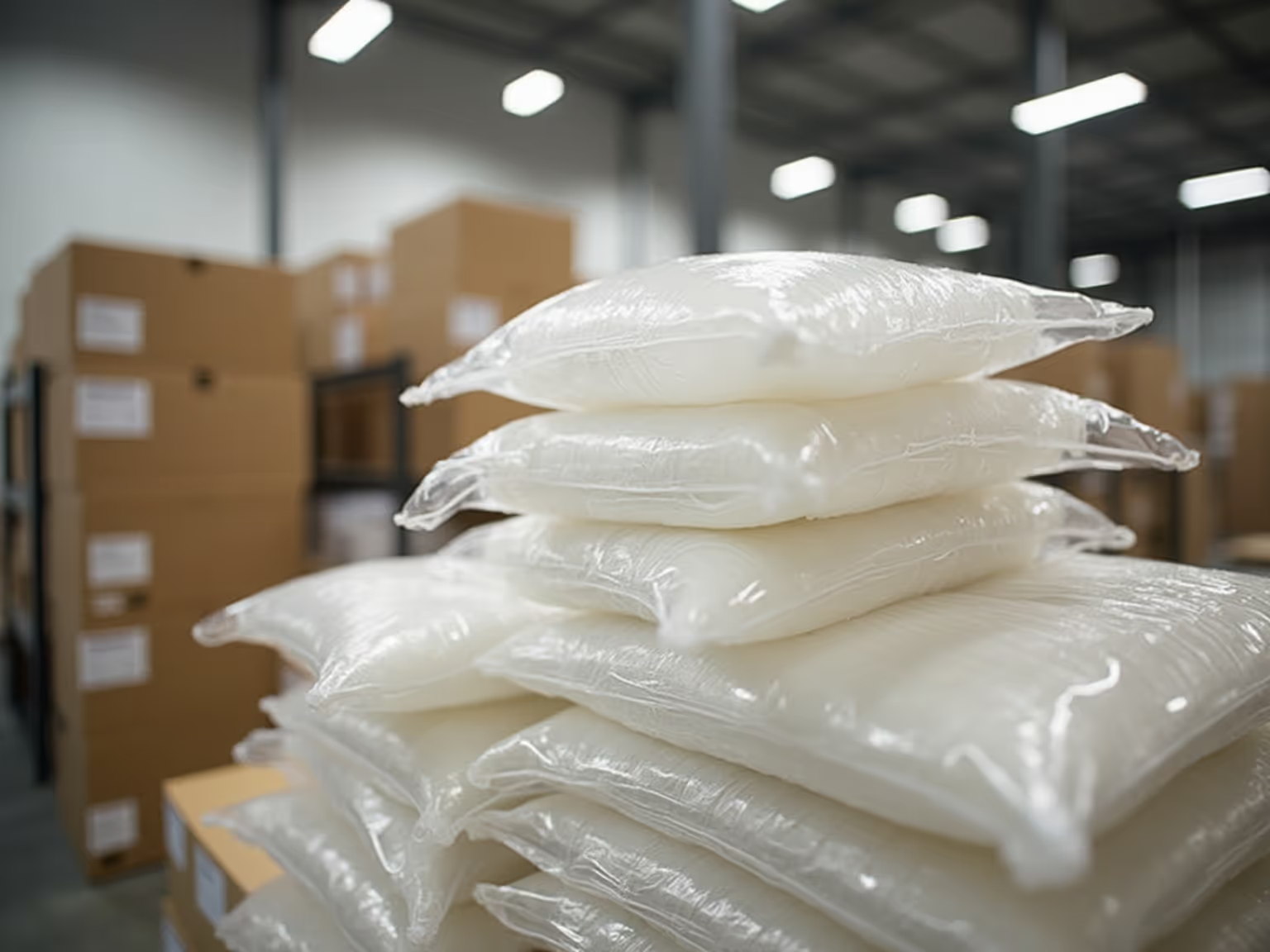
Overview:
Amazon poly bag requirements dictate that poly bags must be transparent, durable, and meet specific size and thickness standards, with proper sealing and suffocation warnings being essential for compliance. The article emphasizes that adherence to these guidelines not only prevents penalties and fulfillment disruptions but also significantly reduces return rates due to quality issues, thereby enhancing seller reputation and customer satisfaction.
Key Highlights:
- Amazon poly bags must be transparent, durable, and adhere to size limits (max 25 inches long, 20 inches wide).
- Proper sealing is crucial to prevent contamination during transit.
- Non-compliance can lead to penalties and fulfillment disruptions.
- All items must have a scannable barcode (minimum size: 1 inch by 2 inches) on the exterior.
- Suffocation warnings must be printed on poly bags to ensure consumer safety.
- Approved poly bag types include standard poly bags, poly mailers, and resealable bags, all made from polyethylene or similar materials.
- Poly bags must be a minimum thickness of 1.5 mils to ensure durability during shipping.
- Common mistakes include failing to include suffocation warnings, using incorrect sizes, and inadequate sealing.
- Adhering to packaging guidelines can prevent up to 60% of returns due to quality issues.
- Best practices include using high-quality materials and regularly reviewing Amazon's guidelines for updates.
Introduction
Navigating the complexities of Amazon's Fulfillment by Amazon (FBA) program requires a keen understanding of packaging regulations, particularly regarding poly bags. These essential components not only serve to protect products during transit but also play a crucial role in maintaining compliance with Amazon's stringent requirements. From ensuring the right dimensions and materials to incorporating mandatory suffocation warnings, sellers must be meticulous in their approach to packaging.
With the potential for significant penalties and disruptions in fulfillment processes, understanding the intricacies of poly bag standards is vital for success. This article delves into the essential requirements, common pitfalls, and best practices for FBA sellers, equipping them with the knowledge needed to safeguard their products and enhance their brand reputation in a competitive marketplace.
Essential Amazon Poly Bag Requirements for FBA Sellers
Amazon poly bag requirements for FBA sellers are essential to ensuring both compliance and item integrity. As outlined in recent guidelines, the Amazon poly bag requirements specify that poly bags must be constructed from transparent, durable plastic and adhere to specific size restrictions—typically a maximum length of 25 inches and width of 20 inches. Furthermore, proper sealing techniques are essential to prevent contamination of items during transit.
It’s worth noting that the implications of non-compliance can be significant, including penalties and disruptions in the fulfillment process. According to Amazon's Package Decision Engine, efficient wrapping has led to a reduction of per-shipment weight by 36% and the elimination of over 2 million tons of material globally, underscoring the importance of compliance. Additionally, grocery items should utilize GMA 1A pallets, while health, personal care, or beauty items can use either GMA 1A or 1B pallets.
All items must also be labeled with a scannable barcode that is at least 1 inch by 2 inches in size, printed in black ink on a white background, and positioned on the exterior of the container. As industry expert Averie Lynch advises,
As always, ensure your labels are correct and high quality
this highlights the importance of meticulous attention to detail in packaging practices. By adhering to these regulations and implementing best-in-class inspections, D2C brand owners can significantly reduce quality issues, prevent up to 60% of returns due to avoidable quality problems, and safeguard their brand reputation against negative reviews, as 94% of customers have avoided making a purchase due to a poor review.
This ultimately fosters a smoother fulfillment experience and positions them favorably within the competitive landscape of FBA. Explore Inspections to learn more about how we can help your brand.
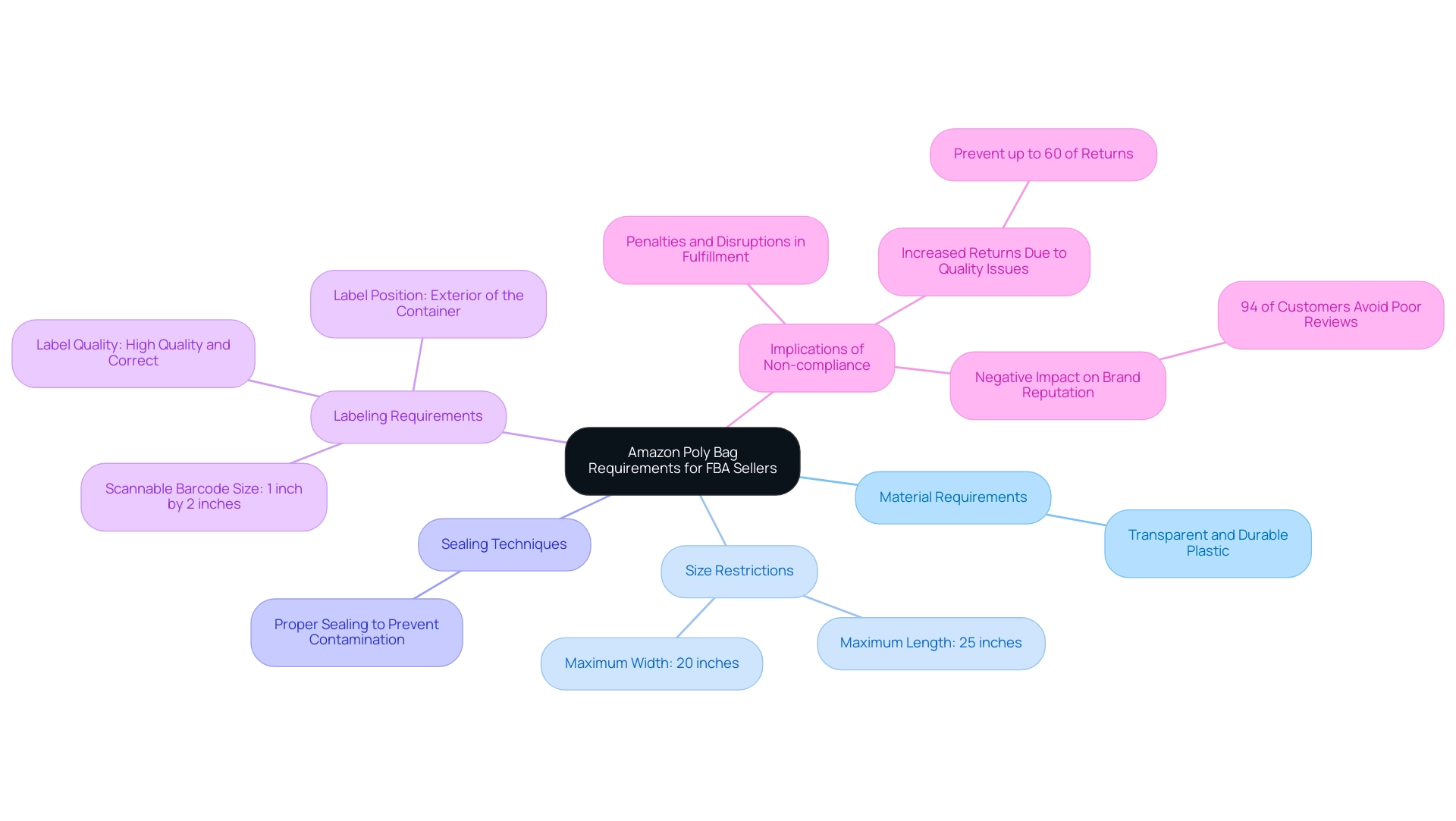
The Importance of Suffocation Warnings on Poly Bags
For all items wrapped in plastic pouches and sold through FBA, compliance with essential suffocation alerts is vital. These warnings must be conspicuously printed, advising consumers of the inherent risks associated with plastic, particularly for young children. The standard warning reads:
'To avoid danger of suffocation, keep this bag away from babies and children.'
This requirement not only fulfills the amazon poly bag requirements but also underscores a brand's dedication to consumer safety. Familiarity with patients at risk of suffocation injuries can improve clinical outcomes, highlighting the importance of such warnings in protecting vulnerable populations. Furthermore, research indicates that while plastic containers can pose a suffocation risk, most fatalities involve larger trash or dry-cleaning sacks rather than typical shopping carriers, suggesting that the perception of danger from plastic containers may be exaggerated.
Implementing these warnings effectively can enhance brand reputation and reassure customers that their well-being is prioritized, aligning with best practices in product presentation.
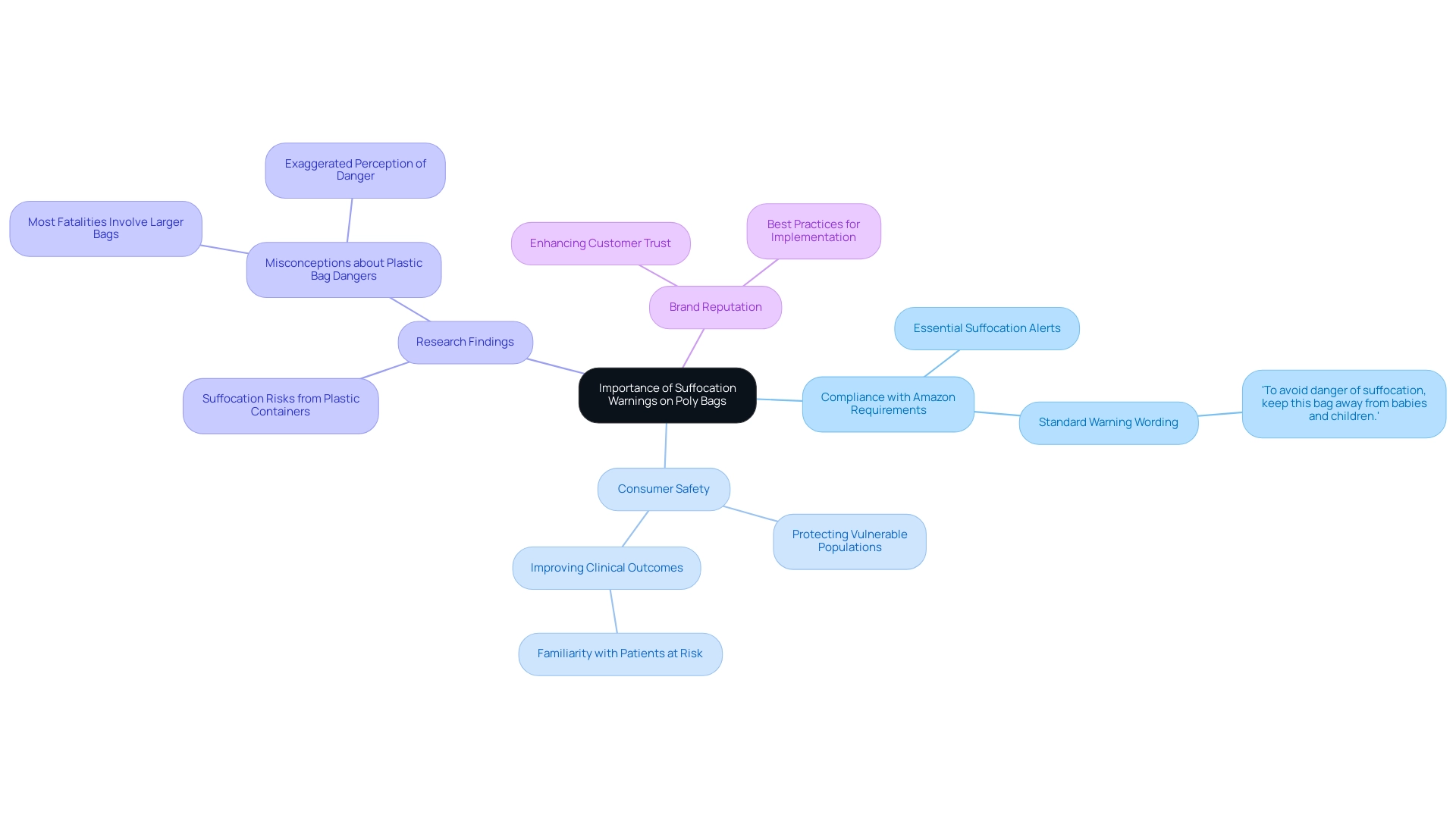
Types of Poly Bags Approved for Amazon FBA
The Fulfillment by the online retailer's program endorses various types of poly bags suitable for sellers, including:
- Standard poly bags
- Poly mailers
- Resealable bags
Each of these must be crafted from polyethylene or comparable robust materials, ensuring they meet the durability standards essential for shipping. Notably, polybags need to be a minimum of 1.5 mils thick to stay strong during transportation.
According to Amazon, 'Messing with Amazon’s FBA rules for container requirements is a recipe for disaster.' This underscores the critical need for compliance, as improper packaging can lead to rejections, fines, or even blocked shipments. The approved bags must also meet specific visibility standards; they should be either opaque or transparent depending on the type of item.
Choosing the appropriate kind of poly bag not only protects the item during transportation but also guarantees compliance with the strict fulfillment standards. For instance, the case study titled 'Choosing the Right Packing Materials Based on Item Type' illustrates that:
- Fragile items necessitate bubble wrap
- Bulky goods require sturdy boxes
- Liquid containers must be sealed in leak-proof packaging
Furthermore, it's important to note that 60% of returns are due to preventable quality issues, highlighting the necessity of on-site inspections.
Partnering with OpsNinja for these inspections can significantly enhance your quality control processes, preventing returns and safeguarding your brand reputation against negative reviews, as 94% of customers have avoided making a purchase due to a bad review. Their expertise has helped sellers like Maurice Mann recover $1 million in revenue by improving product ratings from 3.5 to 4.7 stars, illustrating how transformative quality control can be for scaling businesses on Amazon.
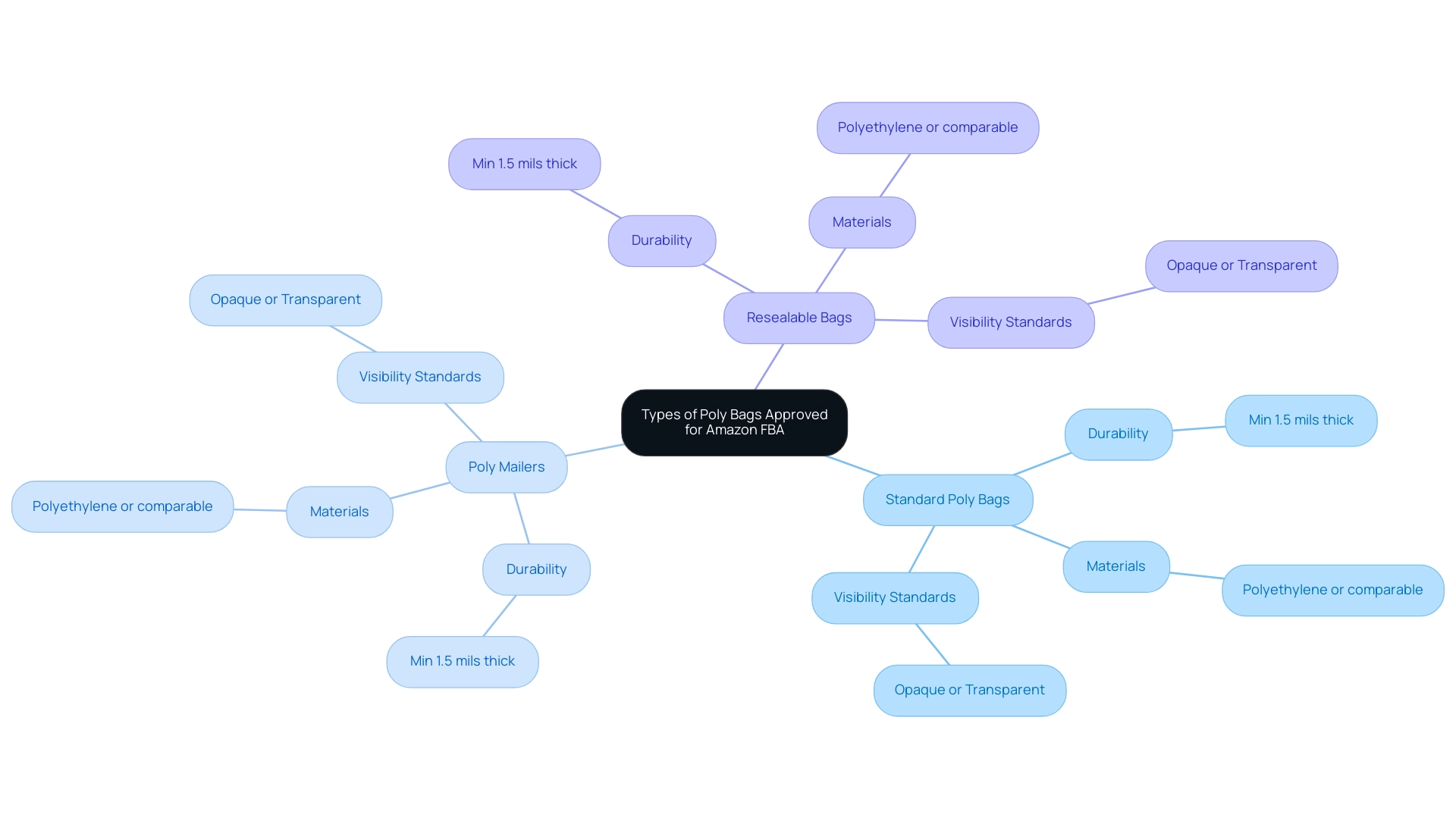
Common Mistakes to Avoid When Using Poly Bags
FBA sellers frequently encounter pitfalls when using poly containers, which can lead to significant compliance issues. Common mistakes include:
- Failing to incorporate mandatory suffocation warnings on poly pouches
- Utilizing non-compliant sizes
- Neglecting to seal them properly, which do not meet the Amazon poly bag requirements
Many sellers also use poly bags that lack sufficient durability, risking damage during transit—a critical factor considering that regular slotted cartons (RSC) must withstand a burst strength of 200 lb./sq. inch. Additionally, for clothing or bundles, product labels can be placed on the poly bag instead of the product, which can streamline the packaging process. Such oversights can lead to shipment refusals, significantly affecting sales potential on the platform.
A case study named 'Meeting FBA Packaging Requirements' demonstrates how sellers adhering to particular guidelines, especially concerning the use of plastic pouches for items that can be handled or possess removable components, can improve customer satisfaction and uphold a positive reputation with the platform. By recognizing these common errors, sellers can implement proactive strategies to ensure their packaging adheres to the Amazon poly bag requirements. As emphasized in industry expert guidance,
'Poly bags should be labeled with the FNSKU or other necessary information by placing the label on a flat surface of the bag. Make sure the label is visible and securely attached.'
Additionally, leveraging OpsNinja's on-site inspections can further ensure product quality and reliability in D2C supply chains, preventing the 60% of returns attributed to preventable quality issues. By utilizing OpsNinja’s services, D2C brand owners can focus on growing their business rather than getting bogged down by operational issues.
Awareness of these issues is essential for maintaining compliance and enhancing overall customer satisfaction, thus safeguarding a seller's standing on the platform. Non-compliance can result in considerable declines in performance metrics, highlighting the necessity for adherence to the company's requirements.
Prevent Returns.
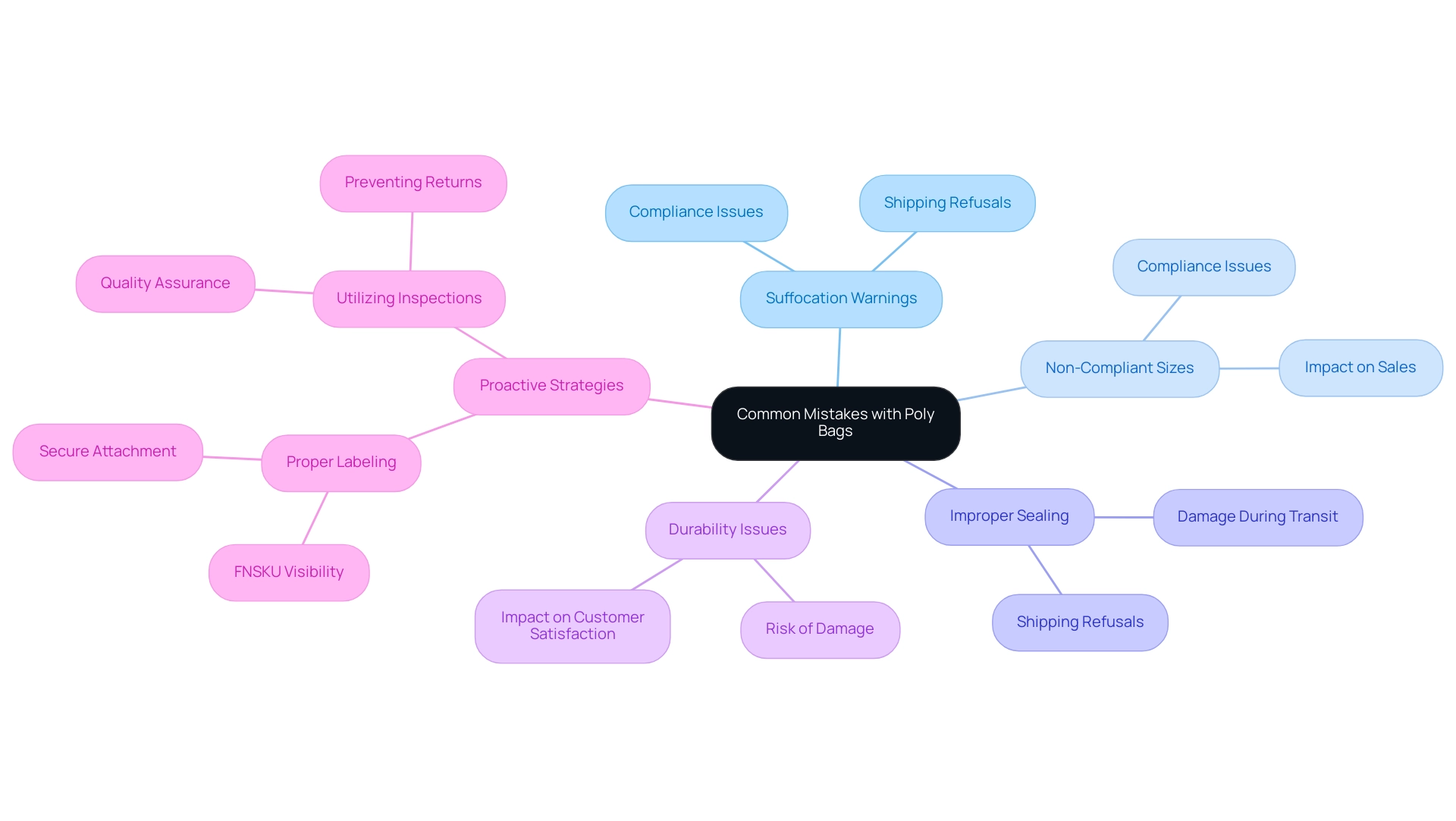
Best Practices for Packaging with Poly Bags in Amazon FBA
To efficiently enhance wrapping with plastic pouches for FBA, sellers must adhere to the Amazon poly bag requirements regarding dimensions and substance. Employing high-quality, durable plastic pouches is essential; these should be able to endure the challenges of shipping, ensuring that delicate items are sufficiently safeguarded to meet the important 3-foot drop test. Suitable wrapping materials for shipments include:
- Bubble wrap
- Heavy-weight Kraft paper
- Poly sacks
- Corrugated boxes
- Air pillows
All of which should meet specific size and weight limits.
It is essential that all bags meet the Amazon poly bag requirements by prominently featuring suffocation warnings in a clearly visible location and being sealed securely to prevent any mishaps during transit. Frequent assessments of the company's guidelines are recommended to remain updated on any modifications or alterations in the Amazon poly bag requirements. As underscored by Daniel Rozario,
So cheers to your success on Amazon FBA!
If you have any questions or need more tips, feel free to reach out. Happy selling! This sentiment captures the supportive spirit necessary for navigating the complexities of FBA logistics.
Moreover, finding the right balance between safety and minimizing environmental impact remains a key challenge for FBA sellers. The case study titled 'Balancing Protection and Eco-Friendliness' illustrates this challenge, highlighting the importance of implementing sustainable practices while ensuring compliance. Strategies such as using recyclable materials and optimizing packaging size can significantly contribute to minimizing environmental impact without compromising product safety.
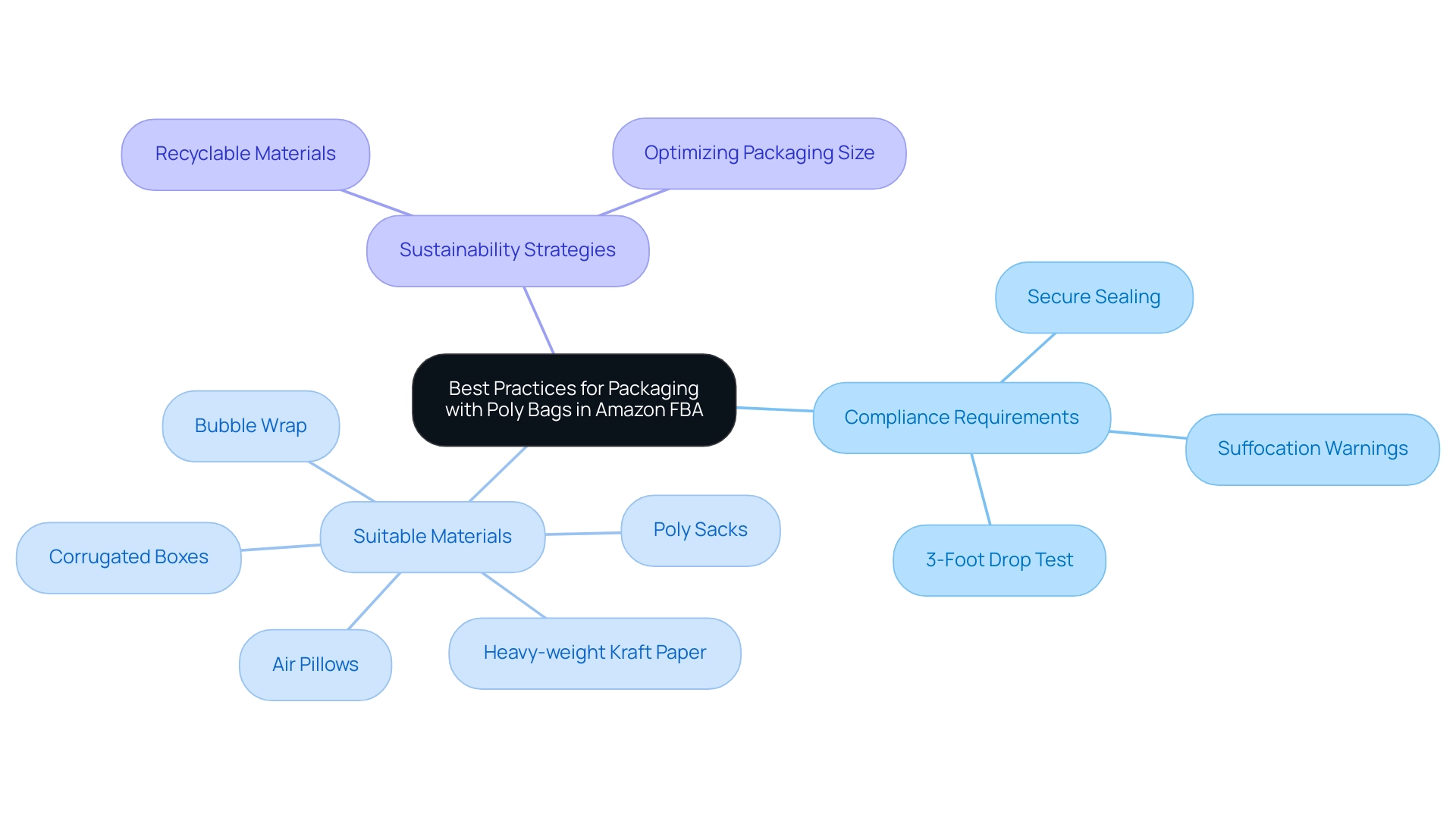
Conclusion
Navigating the requirements of Amazon's Fulfillment by Amazon (FBA) program, particularly regarding poly bags, is critical for maintaining compliance and ensuring product integrity. Adhering to the specific guidelines concerning dimensions, materials, and mandatory suffocation warnings is essential for sellers to avoid penalties and disruptions in their fulfillment processes. The use of durable poly bags and effective sealing methods not only protects products during transit but also enhances customer satisfaction and brand reputation.
Common errors, such as neglecting suffocation warnings or using non-compliant bag sizes, can lead to significant compliance issues, impacting sales potential and overall performance metrics. By recognizing these pitfalls and implementing best practices—such as regular inspections and staying updated with Amazon’s guidelines—sellers can safeguard their products and optimize their packaging strategies.
Ultimately, mastering the intricacies of poly bag standards is not just about compliance; it is about fostering a smooth fulfillment experience that positions sellers favorably in a competitive marketplace. As sellers embrace these best practices, they will not only protect their products but also enhance their brand's reputation, paving the way for sustained success on Amazon.



